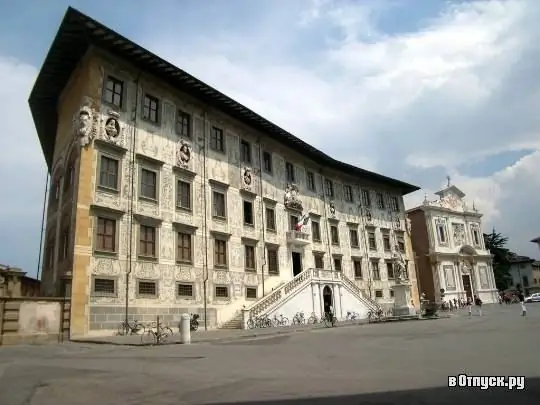
Description of the attraction
Palazzo della Carovana, also known as Palazzo dei Cavalieri, is the former palace of the Order of the Knights of St. Stephen in Pisa, which today houses the City's High Normal School.
The palace was built in 1562-1564 by the famous architect Giorgio Vasari especially for the knightly order. To be precise, Vasari did not build, but radically rebuilt the previously existing Palazzo degli Anziani - the Palace of the Elders. Only small fragments have survived from it, which can be seen on the sides of the building.
The modern name Palazzo della Carovana, which can be translated as the Palace of the Convoy, was given to him, because it was here for three years that new novices of the order were trained to participate in convoys, which were then supposed to fight in the Mediterranean.
The facade of the Palazzo is decorated with intricate sgraffito - a special technique of applying wall painting. Various figures and signs of the zodiac, invented by Vasari himself and made by the sculptors Tommaso di Battista del Verrocchio and Allesandro Forzori, are presented here in allegorical form. Among the sculptures that adorn the palace are the Medici coat of arms and the coat of arms of the Order of St. Stephen, framed by the figures of Faith and Justice by Stoldo Lorenzi. The upper gallery of the busts of the Grand Dukes of Tuscany was added in the late 16th and early 18th centuries by sculptors Ridolfo Sirigatti, Pietro Tacca and Giovanni Battista Foggini. The area behind the Palazzo was slightly altered in the first half of the 20th century for the Higher Normal School of Pisa. Inside, in some rooms, you can still see frescoes and stucco moldings of the 19th century, as well as canvases by artists of the 16th century.
Right in front of Palazzo della Carovana, in the center of Piazza dei Cavalieri, stands a huge statue of Cosimo I Medici. It was made by the sculptor Pietro Francavilla, commissioned by Grand Duke Ferdinando I, son of Cosimo, in 1596. Cosimo is depicted standing on a high pedestal in the mantle of the Grand Master of the Order of St. Stephen - he conquers the dolphin, which is a symbol of his power over the seas. The fountain in front of the statue is made in the form of a shell, decorated with two grotesque monsters.






